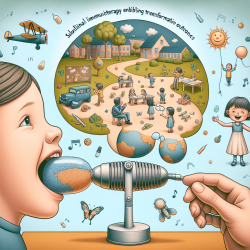Unlocking the Potential of Sublingual Immunotherapy in Pediatric Speech Therapy
In the realm of pediatric speech therapy, the intersection of allergy management and therapeutic outcomes is often overlooked. However, the 2013 update of the World Allergy Organization's position paper on sublingual immunotherapy (SLIT) presents compelling data that could significantly enhance therapeutic outcomes for children. This blog explores how practitioners can leverage these findings to improve their practice and outcomes for children.
The Science Behind SLIT
Sublingual immunotherapy involves administering allergen extracts under the tongue to desensitize patients to specific allergens. The 2013 update highlights the efficacy of SLIT in reducing symptoms of allergic rhinitis and asthma, conditions that can indirectly impact speech and language development in children. By addressing these underlying issues, SLIT can pave the way for more effective speech therapy interventions.
Key Findings from the 2013 Update
- Clinical Efficacy: The update confirms that SLIT is effective in managing symptoms of allergic rhinitis and asthma in children, with long-term benefits observed even after discontinuation of treatment.
- Safety Profile: SLIT has a favorable safety profile, with most adverse reactions being mild and local, making it a viable option for children.
- Impact on Natural History: SLIT may alter the natural course of allergic diseases, potentially preventing the onset of asthma and reducing the development of new sensitizations.
Implications for Pediatric Speech Therapy
Allergic rhinitis and asthma can affect a child's ability to participate in speech therapy sessions due to symptoms like nasal congestion and breathing difficulties. By incorporating SLIT into the treatment plan, practitioners can address these barriers, allowing for more effective therapy sessions. Additionally, the potential for SLIT to prevent asthma development can lead to long-term health benefits, further supporting speech and language development.
Encouraging Further Research
While the data supporting SLIT is robust, further research is needed to explore its full potential in the context of speech therapy. Practitioners are encouraged to collaborate with allergists and researchers to investigate how SLIT can be integrated into comprehensive treatment plans for children with speech and language disorders.
Conclusion
By understanding and implementing the findings of the 2013 SLIT update, practitioners can enhance their therapeutic outcomes for children. As we continue to explore the interplay between allergies and speech therapy, SLIT offers a promising avenue for improving the quality of life and developmental outcomes for children.
To read the original research paper, please follow this link: Sublingual immunotherapy: World Allergy Organization position paper 2013 update.










